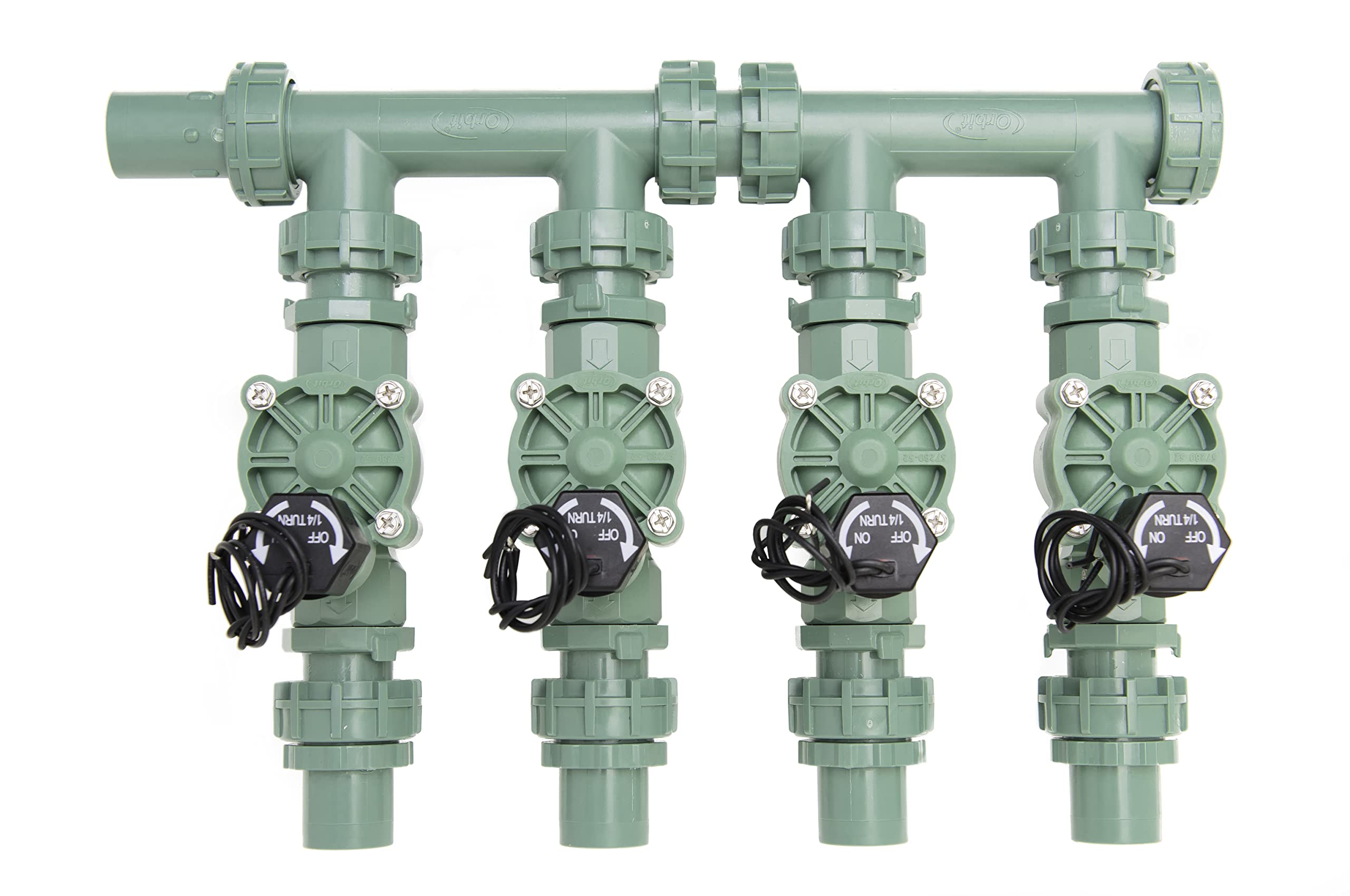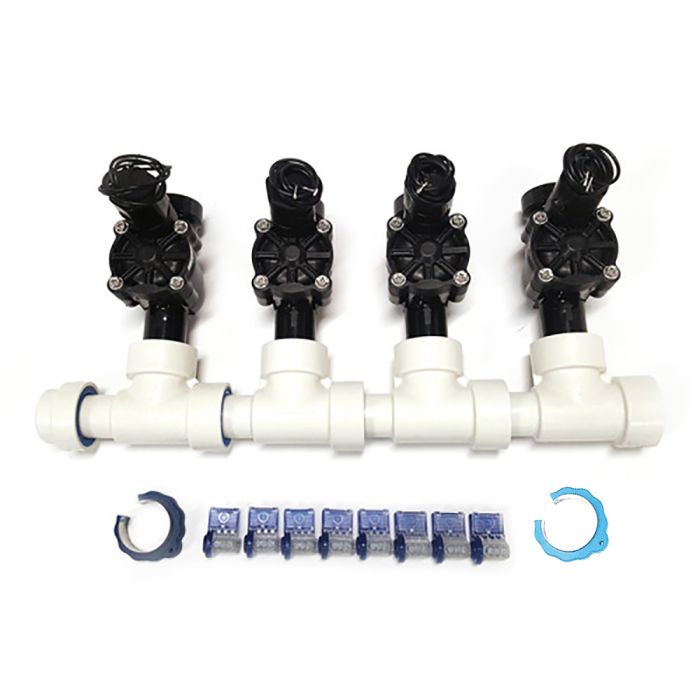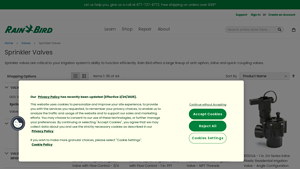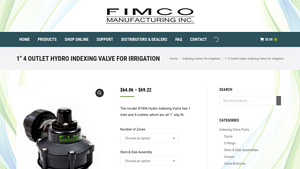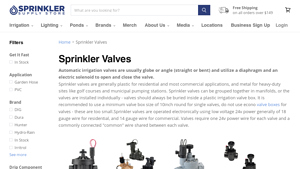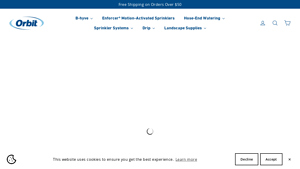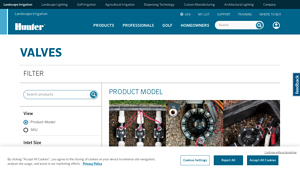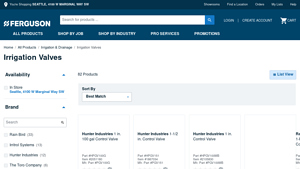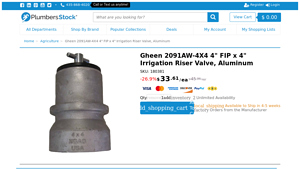Introduction: Navigating the Global Market for 4 irrigation valve
Navigating the complexities of sourcing the right irrigation valves can be a significant challenge for international B2B buyers, particularly in diverse markets across Africa, South America, the Middle East, and Europe. With the increasing demand for efficient water management systems, understanding the various types of 4 irrigation valves—such as anti-siphon, inline, and indexing valves—becomes essential for optimizing agricultural productivity and ensuring sustainable resource use. This comprehensive guide addresses critical aspects of the market, including the different applications of irrigation valves, the intricacies of supplier vetting, and a breakdown of associated costs.
As businesses strive to enhance their irrigation systems, this guide empowers buyers with the knowledge needed to make informed purchasing decisions. It delves into the technical specifications, installation requirements, and best practices for integrating these valves into existing systems. Moreover, by highlighting regional considerations and supplier reliability, the guide aims to foster strong partnerships and ensure that buyers can confidently navigate the global market for irrigation solutions. Whether you’re in Saudi Arabia seeking durable materials for arid landscapes or in Germany looking for innovative technologies, this resource serves as your roadmap to effectively procure the right irrigation valves tailored to your specific needs.
Understanding 4 irrigation valve Types and Variations
| Type Name | Key Distinguishing Features | Primary B2B Applications | Brief Pros & Cons for Buyers |
|---|---|---|---|
| Anti-Siphon Valves | Prevent backflow; typically plastic; flow control options | Residential and light commercial systems | Pros: Cost-effective, easy installation. Cons: Limited durability in harsh conditions. |
| Inline Valves | Installed directly in the pipeline; available in various sizes | Commercial and industrial irrigation | Pros: Versatile, suitable for high-pressure systems. Cons: More complex installation. |
| Indexing Valves | Multi-zone control; allows sequential watering of different areas | Large agricultural and landscaping setups | Pros: Efficient water use, customizable. Cons: Higher initial investment. |
| Quick Coupling Valves | Easy to connect/disconnect; often used for portable systems | Sports fields, temporary setups | Pros: Flexibility, time-saving. Cons: May require more frequent maintenance. |
What Are Anti-Siphon Valves and Their Key Characteristics?
Anti-siphon valves are designed to prevent backflow, ensuring that contaminated water does not enter the main supply. Made primarily from plastic, these valves often come with flow control options, making them suitable for residential and light commercial irrigation systems. Buyers should consider the installation environment, as these valves are cost-effective but may not withstand extreme weather conditions.
How Do Inline Valves Function and Where Are They Used?
Inline valves are integrated directly into the irrigation pipeline, allowing for seamless operation within various irrigation systems. Available in multiple sizes, these valves are ideal for commercial and industrial applications, particularly in high-pressure environments. B2B buyers should assess the complexity of installation and ongoing maintenance, as these valves can require more technical expertise compared to simpler models.
What Makes Indexing Valves Essential for Large Irrigation Systems?
Indexing valves are pivotal for managing multiple zones within larger irrigation systems, allowing for sequential watering based on chosen configurations. This feature makes them especially valuable for agricultural and extensive landscaping projects. Although they offer efficient water use and customization, buyers should be prepared for a higher initial investment and potential complications in setup.
Why Are Quick Coupling Valves Popular for Temporary Irrigation Needs?
Quick coupling valves are designed for easy connection and disconnection, making them particularly useful in portable irrigation systems or temporary setups, such as sports fields. Their flexibility and time-saving capabilities are significant advantages for users who require adaptability in their irrigation solutions. However, buyers should be aware that these valves may necessitate more frequent maintenance to ensure reliability in the field.
Key Industrial Applications of 4 irrigation valve
| Industry/Sector | Specific Application of 4 irrigation valve | Value/Benefit for the Business | Key Sourcing Considerations for this Application |
|---|---|---|---|
| Agriculture | Drip irrigation systems for crop production | Enhances water efficiency and crop yield | Compatibility with local water pressure and soil types |
| Landscaping | Automated sprinkler systems for commercial properties | Reduces labor costs and ensures consistent watering | Durability in various climates and ease of installation |
| Golf Courses | Centralized irrigation management for fairways and greens | Maintains optimal turf health and aesthetics | Ability to integrate with existing systems and automation |
| Municipal Water Management | Control of irrigation in public parks and recreational areas | Ensures sustainable water usage and reduces wastage | Compliance with local regulations and standards |
| Greenhouses and Nurseries | Precision watering for plant health | Supports consistent growth and minimizes disease risk | Requirement for reliable supply and specific valve types |
How Are 4 Irrigation Valves Used in Agriculture?
In the agricultural sector, 4 irrigation valves are integral to drip irrigation systems, which are essential for optimizing water usage in crop production. These valves allow precise control over water flow, ensuring that crops receive the exact amount of water they need. This not only enhances water efficiency but also significantly increases crop yield. For international buyers, especially in regions like Africa and South America, sourcing valves that can withstand varying local water pressures and soil types is crucial to avoid system failures and ensure long-term sustainability.
What Role Do 4 Irrigation Valves Play in Landscaping?
In landscaping, 4 irrigation valves facilitate automated sprinkler systems designed for commercial properties. These systems ensure that lawns and gardens receive consistent watering, which is vital for maintaining aesthetic appeal. By automating the irrigation process, businesses can reduce labor costs while ensuring that their properties remain lush and inviting. Buyers from the Middle East and Europe should prioritize the durability of these valves, as they must withstand extreme weather conditions and require easy installation to minimize disruption.
How Are 4 Irrigation Valves Essential for Golf Courses?
Golf courses utilize 4 irrigation valves in their centralized irrigation management systems, which control water distribution across fairways and greens. These valves help maintain optimal turf health and aesthetics, critical for attracting and retaining players. For buyers in regions like Saudi Arabia and Germany, it is essential to consider valves that can integrate seamlessly with existing systems and offer automation capabilities, ensuring efficient water management in diverse climates.
Why Are 4 Irrigation Valves Important for Municipal Water Management?
In municipal water management, 4 irrigation valves are employed to control water flow in public parks and recreational areas. These valves play a vital role in ensuring sustainable water usage and reducing wastage, aligning with environmental regulations. International buyers should focus on sourcing valves that comply with local regulations and standards, as adherence to these guidelines is crucial for public sector projects.
How Do 4 Irrigation Valves Benefit Greenhouses and Nurseries?
For greenhouses and nurseries, 4 irrigation valves facilitate precision watering, which is critical for plant health. These valves allow for the careful monitoring and control of water supply, reducing the risk of overwatering and associated diseases. Buyers in this sector must ensure a reliable supply of specialized valves that cater to their specific watering needs, enhancing growth conditions and ensuring the health of their plants.
3 Common User Pain Points for ‘4 irrigation valve’ & Their Solutions
Scenario 1: Managing Multiple Irrigation Zones Efficiently
The Problem: For B2B buyers managing large agricultural or landscaping projects, the challenge often lies in effectively controlling multiple irrigation zones. When using a single valve for multiple zones, inefficiencies can arise, leading to uneven watering and potential crop damage. This issue is particularly prevalent in regions with diverse plant requirements or varying soil types, where precise irrigation is critical for maintaining health and productivity.
The Solution: To address this, consider investing in advanced indexing valves, such as the 4-outlet Hydro Indexing Valve. This valve allows for the precise control of up to four zones, enabling tailored watering schedules that meet the specific needs of different areas. When sourcing these valves, ensure compatibility with your existing system by checking the inlet and outlet sizes. Additionally, implementing a smart irrigation control system can optimize water usage and automate adjustments based on real-time weather data. Regular maintenance, including the replacement of worn-out components like O-rings and stem assemblies, will also ensure longevity and optimal performance.
Scenario 2: Ensuring Durability Against Harsh Conditions
The Problem: Many B2B buyers operating in regions like the Middle East or Africa face extreme weather conditions that can severely impact irrigation systems. High temperatures, sandstorms, and heavy rains can lead to valve malfunctions, resulting in costly downtime and repairs. Buyers often struggle to find valves that can withstand these harsh environments while still delivering reliable performance.
The Solution: To combat this, prioritize sourcing irrigation valves made from high-quality, corrosion-resistant materials such as brass or specially treated plastics. These materials offer superior durability and can withstand the rigors of harsh climates. Additionally, consider implementing protective measures such as valve boxes or covers to shield valves from environmental stressors. Regular inspections and proactive maintenance, including checking for leaks and ensuring proper sealing, can also prevent unexpected failures. Partnering with suppliers who offer warranties and support for replacement parts can further enhance the reliability of your irrigation system.
Scenario 3: Troubleshooting Complex Irrigation Issues
The Problem: B2B buyers often encounter complex issues within their irrigation systems that are difficult to diagnose. Problems such as inconsistent water flow, unexpected pressure changes, or system failures can lead to inefficiencies and increased operational costs. For buyers managing large installations, pinpointing the exact cause of these issues can be time-consuming and frustrating.
The Solution: To streamline troubleshooting, invest in valves equipped with built-in indicators or diagnostic features. These innovations allow for easier monitoring of system performance and can help identify issues before they escalate. Additionally, establishing a comprehensive maintenance schedule that includes regular checks of all valves and connections can preemptively address potential problems. Training staff on common troubleshooting techniques and the specific operational parameters of the irrigation valves in use can also enhance overall system reliability. Collaborating with experienced irrigation consultants or engineers can provide valuable insights and tailored solutions for specific challenges faced in your operation.
Strategic Material Selection Guide for 4 irrigation valve
When selecting materials for a 4 irrigation valve, it is essential to consider various factors that affect performance, durability, and compatibility with the intended application. Below, we analyze four common materials used in the manufacturing of irrigation valves: plastic, brass, stainless steel, and ductile iron. Each material presents unique properties, advantages, and limitations that international B2B buyers should consider, particularly in regions such as Africa, South America, the Middle East, and Europe.
What Are the Key Properties of Plastic in 4 Irrigation Valves?
Plastic is a prevalent choice for residential and light commercial irrigation valves, primarily due to its lightweight nature and cost-effectiveness. Typically made from PVC or polypropylene, plastic valves can withstand moderate pressure and temperature variations, generally rated up to 150 psi and 140°F.
Pros: The primary advantages of plastic valves include their resistance to corrosion, lightweight design, and lower manufacturing costs. They are easy to install and maintain, making them suitable for small-scale irrigation systems.
Cons: However, plastic valves may not perform well in extreme temperatures or high-pressure applications. They can also be less durable than metal alternatives, particularly in harsh environmental conditions.
Impact on Application: Plastic valves are compatible with water and non-corrosive liquids but may not be suitable for applications involving chemicals or high salinity.
Considerations for International Buyers: Buyers should ensure compliance with local standards such as ASTM for the United States or DIN for Germany. In regions with high UV exposure, UV-resistant plastics are recommended.
What Are the Advantages of Brass in 4 Irrigation Valves?
Brass is often favored for its strength and durability, making it ideal for heavy-duty applications such as commercial and industrial irrigation. Brass valves typically withstand higher pressure ratings, often exceeding 200 psi, and are resistant to corrosion and wear.
Pros: The key advantage of brass valves is their longevity and reliability in various environmental conditions. They are suitable for applications that require higher pressure and temperature tolerances.
Cons: The primary drawback is the higher cost compared to plastic options. Brass valves can also be heavier, which may complicate installation in some scenarios.
Impact on Application: Brass is compatible with a wide range of media, including potable water, but may not be suitable for acidic or alkaline fluids.
Considerations for International Buyers: Buyers should verify that brass valves meet compliance standards, such as those set by the European Union for drinking water applications. The cost of brass can fluctuate based on market conditions, impacting overall project budgets.
How Does Stainless Steel Perform in 4 Irrigation Valves?
Stainless steel is known for its exceptional corrosion resistance and strength, making it a premium choice for irrigation valves, particularly in coastal or chemically aggressive environments. Stainless steel valves can handle high pressures and temperatures, often rated up to 300 psi and 200°F.
Pros: The durability and resistance to corrosion make stainless steel valves ideal for long-term use in challenging conditions. They also have a sleek appearance, which can be beneficial for visible installations.
Cons: The main disadvantage is the high cost and complexity of manufacturing, which can increase the overall price of the irrigation system.
Impact on Application: Stainless steel valves are suitable for a variety of media, including saline water and chemicals, making them versatile for different irrigation applications.
Considerations for International Buyers: Buyers should ensure compliance with standards such as JIS in Japan or ISO standards globally. The material’s cost can be a significant factor in budget-sensitive projects.
What Role Does Ductile Iron Play in 4 Irrigation Valves?
Ductile iron is a robust material often used in industrial-grade irrigation valves. It offers excellent strength and impact resistance, making it suitable for high-pressure applications.
Pros: The primary advantage of ductile iron is its ability to withstand extreme conditions, including high pressures and temperatures. It is also resistant to wear and fatigue.
Cons: However, ductile iron is heavier and more expensive than plastic, which may limit its use in smaller applications. It also requires protective coatings to prevent corrosion.
Impact on Application: Ductile iron valves are suitable for various media, including water and wastewater, but may not be ideal for corrosive chemicals without proper treatment.
Considerations for International Buyers: Compliance with local standards such as ASTM or DIN is crucial. Buyers should also consider the additional costs associated with protective coatings and installation.
Summary Table of Material Selection for 4 Irrigation Valves
| Material | Typical Use Case for 4 Irrigation Valve | Key Advantage | Key Disadvantage/Limitation | Relative Cost (Low/Med/High) |
|---|---|---|---|---|
| Plastic | Residential and light commercial | Lightweight and cost-effective | Less durable in extreme conditions | Low |
| Brass | Commercial and industrial applications | High durability and pressure tolerance | Higher cost and weight | Med |
| Stainless Steel | Coastal and chemically aggressive areas | Exceptional corrosion resistance | High cost and manufacturing complexity | High |
| Ductile Iron | Industrial-grade applications | Excellent strength and impact resistance | Heavier and requires protective coatings | Med |
This analysis provides a comprehensive overview of the materials available for 4 irrigation valves, enabling international B2B buyers to make informed decisions based on their specific needs and regional considerations.
In-depth Look: Manufacturing Processes and Quality Assurance for 4 irrigation valve
What Are the Key Manufacturing Processes for Irrigation Valves?
The manufacturing of irrigation valves involves several critical stages, each designed to ensure the final product meets specific performance and durability standards. Understanding these processes helps B2B buyers make informed decisions when sourcing irrigation valves for their projects.
How Is Material Prepared for Irrigation Valve Manufacturing?
The first step in the manufacturing process is material selection and preparation. Common materials used for irrigation valves include high-density polyethylene (HDPE), PVC, brass, and stainless steel. Each material has its unique advantages, such as corrosion resistance or strength, which can influence performance in different environments.
Material preparation involves several sub-processes, including cutting, molding, and machining. For plastic valves, the raw material is typically granulated and then heated in an injection molding machine to form valve components. Metal components may undergo machining processes to achieve precise dimensions and tolerances required for optimal functionality.
What Forming Techniques Are Commonly Used in Irrigation Valve Production?
Forming techniques vary based on the material being used. For plastic irrigation valves, injection molding is the primary technique. This method not only allows for complex shapes but also ensures consistency across production runs. The molds used in this process are designed to specific tolerances to ensure a snug fit of valve components.
For metal valves, techniques such as die casting, forging, or CNC machining are employed. Die casting is particularly effective for producing intricate designs with minimal waste. Each forming technique must be chosen based on the valve’s intended use, ensuring it can withstand environmental stresses and maintain functionality over time.
How Does the Assembly Process Work for Irrigation Valves?
Once the individual components are formed, they undergo an assembly process. This involves fitting together various parts such as the valve body, diaphragm, and actuator. Automated assembly lines are often employed to enhance efficiency and consistency, particularly for high-volume production.
During assembly, it’s crucial to ensure that each component is correctly aligned and securely fastened. This is typically achieved using both manual and automated processes, depending on the complexity of the valve design. Key assembly techniques may include the use of O-rings for sealing, which are critical for preventing leaks.
What Finishing Techniques Are Utilized in Irrigation Valve Manufacturing?
Finishing processes are essential to enhance the aesthetics and performance of irrigation valves. Common finishing techniques include surface treatment, coating, and testing for leaks. For plastic valves, UV stabilizers may be added during manufacturing to enhance durability against sun exposure.
Metal valves often undergo processes such as galvanization or powder coating to improve corrosion resistance. These finishing techniques not only prolong the life of the valves but also ensure they meet specific industry standards for quality and safety.
What Are the Quality Assurance Measures in Irrigation Valve Manufacturing?
Quality assurance (QA) is a crucial aspect of the manufacturing process, ensuring that every valve produced meets international standards and customer expectations. This is particularly significant for B2B buyers who depend on reliable performance in their irrigation systems.
Which International Standards Should Buyers Be Aware Of?
International standards such as ISO 9001 play a vital role in the quality assurance of irrigation valves. This standard outlines requirements for a quality management system (QMS) and emphasizes customer satisfaction through consistent product quality. Compliance with ISO standards is often a prerequisite for international trade, ensuring that products meet global benchmarks.
Additionally, industry-specific standards such as CE marking in Europe and API specifications for petroleum-related applications are critical for certain markets. B2B buyers should verify that their suppliers adhere to these standards, as it reflects a commitment to quality and safety.
What Quality Control Checkpoints Are Implemented?
Quality control (QC) involves multiple checkpoints throughout the manufacturing process. Incoming Quality Control (IQC) checks raw materials for defects before they enter production. In-Process Quality Control (IPQC) monitors the manufacturing process to catch any deviations from specifications early on. Finally, Final Quality Control (FQC) ensures that finished products are tested and meet all required specifications.
Common testing methods include hydraulic testing to check for leaks, dimensional checks to verify tolerances, and functional testing to ensure operational efficiency. These QC measures are essential for maintaining high standards and reliability in irrigation valves.
How Can B2B Buyers Verify Supplier Quality Control Practices?
For B2B buyers, verifying the quality control practices of potential suppliers is crucial. This can be achieved through several approaches:
Supplier Audits: Conducting audits allows buyers to assess the manufacturing process firsthand. This includes evaluating the QMS, production capabilities, and adherence to international standards.
Requesting Quality Reports: Suppliers should provide detailed reports on their quality control processes, including any certifications and test results. This documentation can serve as proof of compliance with relevant standards.
Third-Party Inspections: Engaging independent inspection agencies can provide an unbiased assessment of the supplier’s quality control practices. This is particularly important for buyers in regions with stringent quality requirements.
What Are the Quality Control and Certification Nuances for International Buyers?
When sourcing irrigation valves internationally, buyers must be aware of regional certification requirements that may differ from their local standards. For instance, the CE marking is mandatory for products sold in Europe, while other regions may have their own specific requirements.
Understanding these nuances can help B2B buyers navigate the complexities of international trade and ensure compliance with local regulations. It is advisable for buyers to communicate their requirements clearly with suppliers and seek out those with experience in international markets.
In conclusion, a thorough understanding of the manufacturing processes and quality assurance measures for irrigation valves is essential for B2B buyers. By focusing on material preparation, forming techniques, assembly, finishing, and rigorous quality control, buyers can make informed decisions and select reliable suppliers for their irrigation projects.
Practical Sourcing Guide: A Step-by-Step Checklist for ‘4 irrigation valve’
Introduction
This practical sourcing guide serves as a comprehensive checklist for B2B buyers looking to procure 4 irrigation valves. The objective is to streamline the procurement process, ensuring that you make informed decisions that align with your operational needs and regional requirements. By following these steps, you can enhance efficiency, reduce costs, and ensure the longevity of your irrigation systems.
1. Define Your Technical Specifications
Clearly outline the technical specifications for the irrigation valves you require. This includes the type (e.g., anti-siphon, inline, or indexing), size (e.g., 1 inch, 1½ inch), and material (plastic or brass). Precise specifications will help you communicate effectively with suppliers and ensure compatibility with your existing irrigation systems.
2. Research Regional Compliance Standards
Understand the compliance and regulatory standards applicable in your region, especially if you are sourcing from international suppliers. Different countries may have specific certifications or standards (e.g., ISO, CE) that irrigation valves must meet. Ensuring compliance not only avoids legal issues but also guarantees quality and performance.
3. ✅ Verify Supplier Certifications
Before engaging with a supplier, verify their certifications and quality assurance processes. Look for ISO certifications or other relevant industry standards that indicate the supplier’s commitment to quality. This step is crucial as it reduces the risk of purchasing substandard products that may lead to operational failures.
4. Evaluate Potential Suppliers
Conduct thorough research on potential suppliers. Request detailed company profiles, case studies, and references from existing clients, particularly those in similar industries or regions. Engaging with suppliers who have proven track records in your market can significantly enhance the reliability of your procurement process.
5. Compare Pricing and Terms
Gather quotes from multiple suppliers, ensuring you compare not only the pricing but also the payment terms, shipping costs, and delivery timelines. Look for bulk purchase discounts or loyalty programs that could provide additional savings. Understanding the total cost of ownership, including maintenance and warranty, is also essential for effective budgeting.
6. Assess After-Sales Support and Warranty
Evaluate the after-sales support and warranty options provided by the supplier. Reliable after-sales support can be a game-changer in minimizing downtime and ensuring the longevity of your irrigation valves. Ensure that the warranty terms are clear and cover essential components against defects or failures.
7. Plan for Logistics and Supply Chain Management
Finally, develop a logistics plan that accounts for shipping, customs clearance, and local distribution. Consider working with suppliers who have experience navigating the complexities of international shipping, especially in regions like Africa, South America, and the Middle East. Efficient logistics management will help mitigate delays and ensure that your irrigation systems remain operational.
By following this checklist, you can effectively navigate the procurement process for 4 irrigation valves, ensuring that you secure the best products for your needs while optimizing costs and compliance.
Comprehensive Cost and Pricing Analysis for 4 irrigation valve Sourcing
What Are the Key Cost Components in Sourcing 4 Irrigation Valves?
When analyzing the cost structure for sourcing irrigation valves, several components come into play. The primary cost components include materials, labor, manufacturing overhead, tooling, quality control (QC), logistics, and supplier margin.
Materials: The choice of materials significantly affects the pricing. Plastic valves are generally less expensive than metal ones, with prices for common plastic models ranging from $17.75 to $44.00, while brass models can exceed $300. The specific type of irrigation valve (e.g., anti-siphon, inline, or indexing) also dictates material costs.
Labor: Labor costs vary based on geographic location and manufacturing processes. Regions with higher labor costs, such as parts of Europe, may see inflated prices, while manufacturers in regions like South America or Southeast Asia may offer competitive pricing due to lower labor costs.
Manufacturing Overhead: This includes costs associated with utilities, rent, and equipment maintenance. Manufacturers in areas with higher operational costs will likely pass these expenses onto buyers, affecting the overall price.
Tooling: For custom valves or specialized designs, tooling costs can be substantial. Suppliers may require upfront investment in molds or dies, impacting the initial pricing structure.
Quality Control: Investing in quality assurance processes is essential to ensure reliable performance. However, this can increase costs; thus, buyers should consider the balance between quality and price.
Logistics: Shipping costs can vary dramatically based on distance, shipping method, and import/export duties, especially for international buyers. Understanding Incoterms is crucial to evaluating total logistics costs.
Margin: Finally, the supplier’s margin will influence the end price. Negotiating terms can lead to better pricing, especially for bulk orders.
How Do Price Influencers Impact the Cost of 4 Irrigation Valves?
Several factors influence the pricing of irrigation valves, particularly for international buyers:
Volume and Minimum Order Quantity (MOQ): Purchasing in larger volumes typically results in lower per-unit costs. Understanding a supplier’s MOQ can help buyers optimize their orders and negotiate better pricing.
Specifications and Customization: Customized valves designed to meet specific irrigation needs may incur additional costs. Buyers should weigh the benefits of custom solutions against standard options.
Materials and Quality Certifications: Higher-quality materials and certifications (like ISO or NSF) can lead to increased prices. Buyers should assess whether these certifications are necessary for their application.
Supplier Factors: The reputation and reliability of the supplier can influence pricing. Established suppliers may charge a premium for their assurance of quality and service.
Incoterms: Understanding shipping terms and responsibilities can significantly affect total costs. Terms like FOB (Free On Board) or CIF (Cost, Insurance, and Freight) dictate who bears the shipping costs and risks.
What Tips Can Help Buyers Optimize Costs in 4 Irrigation Valve Sourcing?
To enhance cost-efficiency in sourcing irrigation valves, consider the following tips:
Negotiate Terms: Engage in open discussions with suppliers about pricing, especially if you can commit to larger orders. Suppliers may offer discounts or better payment terms for bulk purchases.
Evaluate Total Cost of Ownership (TCO): Beyond initial purchase prices, consider ongoing maintenance and operational costs. Investing in higher-quality valves may reduce long-term expenses related to replacements and repairs.
Research and Compare Suppliers: Conduct thorough research on multiple suppliers, particularly from different regions. This can help identify the best balance of cost, quality, and service.
Stay Informed on Pricing Nuances: International buyers should stay updated on currency fluctuations, local tariffs, and regional economic conditions that may impact pricing.
Utilize Local Partnerships: If possible, work with local distributors who understand the market and can provide insights into cost-saving opportunities.
Disclaimer on Pricing
All prices mentioned are indicative and may vary based on market conditions, supplier quotes, and specific buyer negotiations. It is advisable for buyers to conduct their due diligence and obtain multiple quotes to ensure competitive pricing.
Alternatives Analysis: Comparing 4 irrigation valve With Other Solutions
Exploring Viable Alternatives to the ‘4 Irrigation Valve’
In the quest for efficient irrigation solutions, B2B buyers often consider various technologies that can meet their agricultural and landscaping needs. This analysis compares the ‘4 irrigation valve’ with two viable alternatives: Indexing Valves and Smart Irrigation Controllers. Each alternative presents unique benefits and challenges that cater to different operational requirements and environmental conditions.
| Comparison Aspect | ‘4 Irrigation Valve’ | Indexing Valve | Smart Irrigation Controller |
|---|---|---|---|
| Performance | Reliable for multiple zones | Efficient for sequential watering | Adaptive to weather conditions |
| Cost | Moderate (varies by size and type) | Lower upfront cost | Higher initial investment |
| Ease of Implementation | Simple installation | Relatively easy to set up | Requires integration with sensors |
| Maintenance | Moderate (occasional cleaning needed) | Low (minimal moving parts) | Moderate (software updates required) |
| Best Use Case | Large-scale agricultural systems | Small to medium gardens | Residential and commercial landscapes |
What Are the Advantages and Disadvantages of Indexing Valves?
Indexing valves are designed to control multiple zones with one valve, making them a popular choice for smaller gardens or farms. Their simplicity allows for easy installation, and they require minimal maintenance due to fewer moving parts. However, their performance is limited to sequential watering, which may not be suitable for larger applications requiring simultaneous operation. Additionally, while indexing valves have a lower initial cost, their efficiency can decrease in larger setups where multiple zones need to be managed at once.
How Do Smart Irrigation Controllers Enhance Irrigation Systems?
Smart irrigation controllers utilize advanced technology to adjust watering schedules based on real-time weather data, soil moisture levels, and other environmental factors. This adaptability can lead to significant water savings and optimized plant health, making them ideal for both residential and commercial landscaping. However, the initial investment in smart technology can be higher than traditional methods, and they may require a more complex installation process, including integration with various sensors and systems. Maintenance involves occasional software updates, which may require technical know-how.
Conclusion: How to Choose the Right Irrigation Solution
Selecting the right irrigation solution hinges on understanding specific operational needs and environmental conditions. For B2B buyers, evaluating the scale of the irrigation system, budget constraints, and desired efficiency levels is crucial. The ‘4 irrigation valve’ offers a reliable and versatile option for larger agricultural systems, while indexing valves are suited for smaller applications. In contrast, smart irrigation controllers provide advanced features that can enhance efficiency and sustainability but may come with higher upfront costs. By weighing these factors, buyers can make informed decisions that align with their operational goals and resource management strategies.
Essential Technical Properties and Trade Terminology for 4 irrigation valve
What Are the Key Technical Properties of a 4 Irrigation Valve?
Understanding the technical specifications of a 4 irrigation valve is crucial for ensuring efficient operation and compatibility with your irrigation system. Here are some essential properties to consider:
Material Composition
The material grade of an irrigation valve significantly affects its durability and performance. Common materials include high-density polyethylene (HDPE) and brass. HDPE is lightweight and resistant to corrosion, making it ideal for various environments, while brass provides strength and longevity, suitable for heavy-duty applications. Selecting the right material ensures your valve can withstand environmental factors and operational pressures.Flow Rate
This specification indicates the maximum volume of water the valve can handle, typically measured in gallons per minute (GPM). For example, a valve with a flow rate of 10 GPM is suitable for smaller irrigation systems, while larger operations may require valves that can handle 20 GPM or more. Understanding flow rates is essential for optimizing system performance and ensuring adequate water distribution across zones.Inlet/Outlet Size
The inlet and outlet sizes determine how easily water flows into and out of the valve. Sizes can range from ¾ inch to 2 inches, and choosing the correct dimensions is vital for compatibility with existing piping. Mismatched sizes can lead to pressure issues or inefficient water delivery, impacting overall irrigation efficacy.Operating Pressure
This specification refers to the pressure range within which the valve operates effectively, typically measured in pounds per square inch (PSI). A valve designed for high-pressure systems is necessary for commercial applications, while lower pressures may be suitable for residential settings. Proper pressure management is crucial to avoid valve failure and system leaks.Actuation Method
Valves can be actuated mechanically or electronically. Electronic valves, often equipped with solenoids, provide precise control over water flow, allowing for automation within irrigation systems. Mechanical valves may be simpler but can lack the responsiveness needed for modern, automated setups. Understanding the actuation method helps in selecting a valve that meets operational needs.
What Common Trade Terms Should B2B Buyers Know About Irrigation Valves?
Familiarizing yourself with industry terminology will enhance communication with suppliers and improve purchasing decisions. Here are some key trade terms relevant to irrigation valves:
OEM (Original Equipment Manufacturer)
An OEM produces components that are integrated into another company’s end product. When sourcing irrigation valves, buyers often seek OEM parts to ensure compatibility and quality. Understanding OEM status helps buyers recognize the reliability of products and their sources.MOQ (Minimum Order Quantity)
This term refers to the smallest quantity of a product that a supplier is willing to sell. Knowing the MOQ is vital for budgeting and inventory management, especially when dealing with larger irrigation projects. Suppliers may offer lower MOQs for trial orders, which can be beneficial for initial evaluations.RFQ (Request for Quotation)
An RFQ is a formal document sent to suppliers requesting pricing and terms for specific products. Issuing an RFQ allows buyers to compare offers and negotiate better deals. It is an essential step in the procurement process, particularly for bulk purchases.Incoterms (International Commercial Terms)
These are standardized terms that define the responsibilities of buyers and sellers in international transactions. Familiarity with Incoterms helps clarify shipping costs, risk management, and delivery responsibilities, which are crucial when importing irrigation valves from international suppliers.Pressure Rating
This term indicates the maximum pressure a valve can withstand without failure. Understanding pressure ratings is essential for ensuring that the valve will perform reliably under the specific conditions of your irrigation system.
By grasping these technical properties and trade terms, B2B buyers can make informed decisions when sourcing 4 irrigation valves, ensuring compatibility, efficiency, and long-term success in their irrigation projects.
Navigating Market Dynamics and Sourcing Trends in the 4 irrigation valve Sector
What are the Key Trends Driving the 4 Irrigation Valve Market?
The global irrigation valve market is witnessing transformative changes driven by a combination of technological advancements, increased agricultural efficiency demands, and sustainability initiatives. Key trends include the rising adoption of smart irrigation systems, which integrate IoT technologies for real-time monitoring and management. This trend is particularly pronounced in regions such as Europe and the Middle East, where water scarcity is a pressing concern. B2B buyers are increasingly seeking valves that support automation, enabling efficient resource management and reduced labor costs.
Moreover, the emergence of eco-friendly materials in valve manufacturing is gaining traction. As agricultural practices shift towards sustainability, buyers from Africa and South America are prioritizing suppliers who offer products made from recycled or biodegradable materials. This shift not only meets regulatory requirements but also aligns with the global push for sustainable agricultural practices. Additionally, the market is seeing a shift towards modular and customizable valve solutions, allowing buyers to tailor systems to specific irrigation needs, thus enhancing operational efficiency.
How is Sustainability Shaping the Sourcing of 4 Irrigation Valves?
The environmental impact of traditional irrigation practices has prompted a significant shift towards sustainable sourcing in the irrigation valve sector. B2B buyers are increasingly aware of the need for ethical supply chains that prioritize sustainability. This includes sourcing from manufacturers that adhere to environmentally friendly practices, such as utilizing recyclable materials and reducing waste during production.
Certifications like ISO 14001 for environmental management and the use of ‘green’ materials are becoming critical factors for buyers when evaluating suppliers. These certifications not only enhance a brand’s credibility but also assure buyers of the supplier’s commitment to sustainable practices. Furthermore, the demand for valves that support water conservation and efficient usage is on the rise, as companies recognize the importance of preserving water resources in agricultural processes. By prioritizing sustainable sourcing, B2B buyers can contribute to environmental conservation while also meeting the growing consumer demand for eco-friendly products.
What is the Historical Context of the 4 Irrigation Valve Market?
The evolution of the irrigation valve market can be traced back to the early days of agricultural development, where manual systems dominated. As the agricultural sector began to industrialize, the introduction of mechanized irrigation systems in the mid-20th century marked a significant turning point. Initially, these systems relied heavily on basic valve technology that lacked the precision and efficiency of today’s solutions.
With advancements in materials science and engineering, the introduction of plastic and composite materials in valve manufacturing allowed for lighter, more durable products that significantly improved performance. The late 20th and early 21st centuries saw the emergence of automated and smart irrigation systems, integrating advanced technologies such as sensors and data analytics. This shift has not only enhanced operational efficiency but has also addressed critical issues such as water scarcity and sustainable farming practices. Today, B2B buyers benefit from a rich history of innovation that continues to shape the future of irrigation technology, making informed sourcing decisions easier and more impactful.
Frequently Asked Questions (FAQs) for B2B Buyers of 4 irrigation valve
How do I choose the right irrigation valve for my needs?
Choosing the right irrigation valve involves assessing several factors, including the type of irrigation system, flow requirements, and pressure ratings. Consider the application—residential, commercial, or industrial—as this influences material choices (plastic vs. metal). Additionally, evaluate valve configurations such as anti-siphon, inline, or quick-coupling to match your system’s design. Consulting with a supplier about your specific irrigation setup can also help in selecting the most suitable valve.What is the best type of irrigation valve for commercial use?
For commercial applications, brass or heavy-duty plastic valves are often recommended due to their durability and resistance to pressure fluctuations. Inline valves are particularly effective for larger systems requiring robust performance. Additionally, consider valves with flow control features for precise water management. It’s advisable to consult with manufacturers or suppliers who can provide insights based on similar projects in your region.What are the common customization options for irrigation valves?
Customization options for irrigation valves may include size, threading type, and additional features like flow control or zone indicators. Suppliers may also offer different materials suited for specific environmental conditions, such as UV-resistant plastic for sunny regions or corrosion-resistant metals for coastal areas. Discussing your requirements with suppliers can yield tailored solutions that enhance efficiency and longevity in your irrigation system.What are the minimum order quantities (MOQ) for irrigation valves?
Minimum order quantities for irrigation valves can vary significantly between suppliers, typically ranging from 10 to 100 units. Some manufacturers may offer flexibility for smaller orders, particularly for new customers or trials. It’s essential to confirm MOQs directly with suppliers, especially when sourcing internationally, to ensure that your purchasing strategy aligns with their terms and your operational needs.What payment terms should I expect when sourcing irrigation valves internationally?
Payment terms can vary widely based on the supplier and the nature of the transaction. Common arrangements include a 30% deposit upon order confirmation with the balance due before shipment. Letters of credit or payment through secure platforms may also be options for larger transactions. Always clarify payment terms upfront to avoid misunderstandings and ensure that they align with your cash flow requirements.How can I ensure quality assurance when sourcing irrigation valves?
To ensure quality assurance, request certifications and compliance documentation from suppliers, such as ISO standards or local regulatory approvals. Conducting factory audits or requesting samples for testing can also help verify product quality. Additionally, consider working with suppliers who offer warranties or guarantees, as this can provide further assurance of their commitment to quality.What logistics considerations should I be aware of when importing irrigation valves?
Logistics considerations include shipping methods, customs regulations, and potential tariffs. Choose a reliable shipping partner who understands the nuances of importing goods into your region. It’s also vital to account for lead times, especially if you require valves for seasonal projects. Understanding the logistics process will help you manage timelines and costs effectively.How do I vet suppliers for irrigation valves in international markets?
Vetting suppliers involves researching their reputation, experience, and customer reviews. Request references and case studies to gauge their reliability. Additionally, verify their manufacturing capabilities and compliance with international standards. Attending industry trade shows or leveraging platforms like Alibaba or ThomasNet can also help you identify credible suppliers, especially in emerging markets.
Important Disclaimer & Terms of Use
⚠️ Important Disclaimer
The information provided in this guide, including content regarding manufacturers, technical specifications, and market analysis, is for informational and educational purposes only. It does not constitute professional procurement advice, financial advice, or legal advice.
While we have made every effort to ensure the accuracy and timeliness of the information, we are not responsible for any errors, omissions, or outdated information. Market conditions, company details, and technical standards are subject to change.
B2B buyers must conduct their own independent and thorough due diligence before making any purchasing decisions. This includes contacting suppliers directly, verifying certifications, requesting samples, and seeking professional consultation. The risk of relying on any information in this guide is borne solely by the reader.
Top 7 4 Irrigation Valve Manufacturers & Suppliers List
1. Rainbird – Free Delivery on Orders Over $99
Domain: store.rainbird.com
Registered: 1995 (30 years)
Introduction: This company, Rainbird – Free Delivery on Orders Over $99, is a notable entity in the market. For specific product details, it is recommended to visit their website directly.
2. Fimco – 1 Hydro Indexing Valve for Multi-Zone Irrigation
Domain: fimcomfg.com
Registered: 2002 (23 years)
Introduction: 1″ Indexing Valve for 2, 3, or 4 Zones – Model #1004 Hydro Indexing Valve
– Price Range: $64.06 – $69.22
– Inlet: 1″ slip fit
– Outlets: 4 (1″ slip fit each)
– Recommended for city water irrigation systems
– Configurable for 2, 3, or 4 zones based on cam configuration
– Available Stem & Disk Assembly Options:
– Standard Flow (requires minimum 10 GPM)
– Low Flow (requires minimum 6 GPM)
– Opti…
3. Sprinkler Supply Store – Sprinkler Valves
Domain: sprinklersupplystore.com
Registered: 2010 (15 years)
Introduction: Sprinkler valves are automatic irrigation valves that can be globe or angle (straight or bent) types. They utilize a diaphragm and an electric solenoid to open and close. Typically, sprinkler valves are made of plastic for residential and most commercial applications, while metal valves are used for heavy-duty sites such as golf courses and municipal pumping stations.
4. Orbit – Top Underground Valves for Sprinkler and Drip Systems
Domain: orbitonline.com
Registered: 1999 (26 years)
Introduction: Top Underground Valves for Sprinkler and Drip Systems
5. Hunter Irrigation – Key Products
Domain: hunterirrigation.com
Registered: 2001 (24 years)
Introduction: {“products”:[{“model”:”1″},{“model”:”1½”},{“model”:”2″},{“model”:”ICV”},{“model”:”IBV”},{“model”:”PGV-ASV”},{“model”:”Accu Sync®”},{“model”:”Quick Couplers”},{“model”:”Wireless Valve Link”},{“model”:”Drip Control Zone Kits”},{“model”:”PGV Jar-Top”}],”sizes”:[{“inlet_size”:”¾”},{“inlet_size”:”1″},{“inlet_size”:”1¼”},{“inlet_size”:”1½”},{“inlet_size”:”2″},{“inlet_size”:”3″}]}
6. Ferguson – Plastic Residential Irrigation Control Valve
Domain: ferguson.com
Registered: 1999 (26 years)
Introduction: This company, Ferguson – Plastic Residential Irrigation Control Valve, is a notable entity in the market. For specific product details, it is recommended to visit their website directly.
7. Gheen – 4 FIP x 4 Irrigation Riser Valve
Domain: plumbersstock.com
Registered: 2007 (18 years)
Introduction: {“Product Name”: “Gheen 2091AW-4X4 4″ FIP x 4″ Irrigation Riser Valve, Aluminum”, “SKU”: “180381”, “Price”: “$33.61 / ea (was $45.96 / ea)”, “Shipping Dimensions”: “8.0 \” x 5.0 \” x 3.8 \””, “Weight”: “2.94 lbs.”, “Material”: “Aluminum”, “Finish”: “Brass”, “Warranty”: “50 Years”, “Availability”: “Available to Ship in 4-5 weeks”, “Return Policy”: “Non-Returnable Product”}
Strategic Sourcing Conclusion and Outlook for 4 irrigation valve
In summary, strategic sourcing of irrigation valves is essential for optimizing both efficiency and cost-effectiveness in agricultural and landscaping applications. By investing in high-quality valves, such as anti-siphon and inline models, buyers can enhance the performance of their irrigation systems, ensuring reliable water distribution that meets the specific needs of diverse environments. Furthermore, understanding regional requirements and technical specifications is crucial for international buyers, particularly those in Africa, South America, the Middle East, and Europe.
The value of strategic sourcing extends beyond immediate purchases; it fosters long-term partnerships with manufacturers and suppliers, leading to improved service, product availability, and innovation. As global agricultural practices evolve, the demand for advanced irrigation solutions will only increase.
International buyers should proactively engage with suppliers who can provide tailored solutions and robust support. By doing so, they can not only secure optimal products but also contribute to sustainable agricultural practices. Now is the time to leverage strategic sourcing to elevate your irrigation systems and enhance agricultural productivity.

